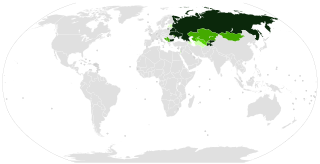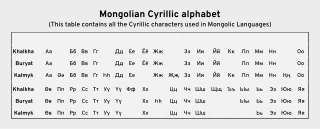The Africa Alphabet is a set of letters designed as the basis for Latin alphabets for the languages of Africa. It was initially developed in 1928 by the International Institute of African Languages and Cultures from a combination of the English alphabet and the International Phonetic Alphabet (IPA). Development was assisted by native speakers of African languages and led by Diedrich Hermann Westermann, who served as director of the organization from 1926 to 1939. The aim of the International Institute of African Languages and Cultures, later renamed the International African Institute (IAI), was to enable people to write for practical and scientific purposes in all African languages without the need of diacritics.

The Cyrillic script, Slavonic script or simply Slavic script is a writing system used for various languages across Eurasia. It is the designated national script in various Slavic, Turkic, Mongolic, Uralic, Caucasian and Iranic-speaking countries in Southeastern Europe, Eastern Europe, the Caucasus, Central Asia, North Asia, and East Asia, and used by many other minority languages.

A diacritic is a glyph added to a letter or to a basic glyph. The term derives from the Ancient Greek διακριτικός, from διακρίνω. The word diacritic is a noun, though it is sometimes used in an attributive sense, whereas diacritical is only an adjective. Some diacritics, such as the acute ⟨ó⟩, grave ⟨ò⟩, and circumflex ⟨ô⟩, are often called accents. Diacritics may appear above or below a letter or in some other position such as within the letter or between two letters.

The Standard Alphabet is a Latin-script alphabet developed by Karl Richard Lepsius. Lepsius initially used it to transcribe Egyptian hieroglyphs in his Denkmäler aus Ägypten und Äthiopien and extended it to write African languages, published in 1853, 1854 and 1855, and in a revised edition in 1863. The alphabet was comprehensive but was not used much as it contained a lot of diacritic marks and was difficult to read and typeset at that time. It was, however, influential in later projects such as Ellis's Paleotype, and diacritics such as the acute accent for palatalization, under-dot for retroflex, underline for Arabic emphatics, and the click letters continue in modern use.
The Coptic alphabet is the script used for writing the Coptic language, the most recent development of Egyptian. The repertoire of glyphs is based on the uncial Greek alphabet, augmented by letters borrowed from the Egyptian Demotic. It was the first alphabetic script used for the Egyptian language. There are several Coptic alphabets, as the script varies greatly among the various dialects and eras of the Coptic language.

A breve is the diacritic mark ◌̆, shaped like the bottom half of a circle. As used in Ancient Greek, it is also called brachy, βραχύ. It resembles the caron but is rounded, in contrast to the angular tip of the caron. In many forms of Latin, ◌̆ is used for a shorter, softer variant of a vowel, such as "Ĭ", where the sound is nearly identical to the English /i/.

The Ugaritic writing system is a cuneiform abjad with syllabic elements used from around either 1400 BCE or 1300 BCE for Ugaritic, an extinct Northwest Semitic language. It was discovered in Ugarit, modern Ras Shamra, Syria, in 1928. It has 30 letters. Other languages, particularly Hurrian, were occasionally written in the Ugaritic script in the area around Ugarit, although not elsewhere.
A caronKARR-ən. or háček, is a diacritic mark placed over certain letters in the orthography of some languages, to indicate a change of the related letter's pronunciation. Typographers tend to use the term caron, while linguists prefer the Czech word háček.
The African Reference Alphabet is a largely defunct continent-wide guideline for the creation of Latin alphabets for African languages. Two variants of the initial proposal were made at a 1978 UNESCO-organized conference held in Niamey, Niger. They were based on the results of several earlier conferences on the harmonization of established Latin alphabets of individual languages. The 1978 conference recommended the use of single letters for speech sounds rather than of letter sequences or of letters with diacritics. A substantial overhaul was proposed in 1982 but was rejected in a follow-up conference held in Niamey in 1984. Since then, continent-wide harmonization has been largely abandoned, because regional needs, practices and thus preferences differ greatly across Africa.
The Albanian alphabet is a variant of the Latin alphabet used to write the Albanian language. It consists of 36 letters:

The Syriac alphabet is a writing system primarily used to write the Syriac language since the 1st century AD. It is one of the Semitic abjads descending from the Aramaic alphabet through the Palmyrene alphabet, and shares similarities with the Phoenician, Hebrew, Arabic and Sogdian, the precursor and a direct ancestor of the traditional Mongolian scripts.

Zhe, Zha, or Zhu, sometimes transliterated as Že is a letter of the Cyrillic script. It commonly represents the voiced retroflex sibilant (listen) or voiced postalveolar fricative /ʒ/, like the pronunciation of the ⟨s⟩ in "measure". It is also often used with D (Д) to approximate the sound in English of the Latin letter J with a ДЖ combination. Zhe is romanized as ⟨zh⟩, ⟨j⟩ or ⟨ž⟩.

The Latin script, also known as the Roman script, is a writing system based on the letters of the classical Latin alphabet, derived from a form of the Greek alphabet which was in use in the ancient Greek city of Cumae in Magna Graecia. The Greek alphabet was altered by the Etruscans, and subsequently their alphabet was altered by the Ancient Romans. Several Latin-script alphabets exist, which differ in graphemes, collation and phonetic values from the classical Latin alphabet.

The Serbian Cyrillic alphabet is a variation of the Cyrillic script used to write the Serbian language originated in medieval Serbia. Reformed in 19th century by the Serbian philologist and linguist Vuk Karadžić. It is one of the two alphabets used to write modern standard Serbian, the other being Gaj's Latin alphabet.

Romanization of Georgian is the process of transliterating the Georgian language from the Georgian script into the Latin script.
The Mongolian Latin script was officially adopted in Mongolia in 1931. In 1939, a second version of the Latin alphabet was introduced but not widely used, and was replaced by the Cyrillic script in 1941.

Numerous Cyrillic alphabets are based on the Cyrillic script. The early Cyrillic alphabet was developed in the 9th century AD and replaced the earlier Glagolitic script developed by the theologians Cyril and Methodius. It is the basis of alphabets used in various languages, past and present, Slavic origin, and non-Slavic languages influenced by Russian. As of 2011, around 252 million people in Eurasia use it as the official alphabet for their national languages. About half of them are in Russia. Cyrillic is one of the most-used writing systems in the world. The creator is Saint Clement of Ohrid from the Preslav literary school in the First Bulgarian Empire.

The Mongolian Cyrillic alphabet is the writing system used for the standard dialect of the Mongolian language in the modern state of Mongolia. It has a largely phonemic orthography, meaning that there is a fair degree of consistency in the representation of individual sounds. Cyrillic has not been adopted as the writing system in the Inner Mongolia region of China, which continues to use the traditional Mongolian script.

Various letters have been used to write the click consonants of southern Africa. The precursors of the current IPA letters, ⟨ǀ⟩ ⟨ǁ⟩ ⟨ǃ⟩ ⟨ǂ⟩, were created by Karl Richard Lepsius and used by Wilhelm Bleek and Lucy Lloyd, who added ⟨ʘ⟩. Also influential were Daniel Jones, who created the letters ⟨ʇ⟩ ⟨ʖ⟩ ⟨ʗ⟩ ⟨ʞ⟩ that were promoted by the IPA from 1921 to 1989, and were used by Clement Doke and Douglas Beach.













